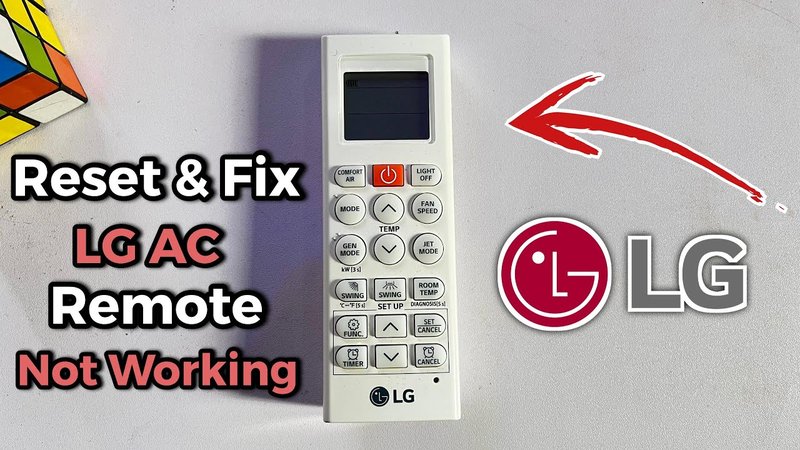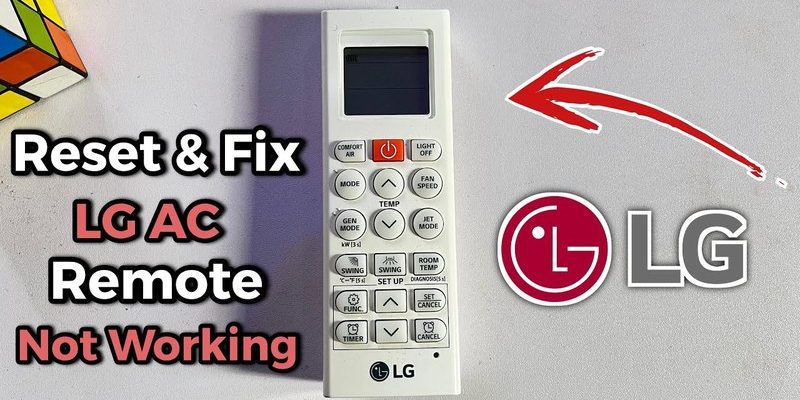
Honestly, it can feel a bit like being locked out of your own house by your cat… except the “cat” is an LG AC remote. And trust me, you’re not alone. Whether you’ve just bought your LG split AC or it’s been humming in the corner for years, the remote (officially called an LG AC remote, but sometimes it’s just “the clicker”) can be finicky. There are a bunch of perfectly normal reasons for this—dead batteries, lost sync, weird codes, or even the universe just having a laugh at your expense. The good news? Most of the time you can get things working again without calling a technician or learning ancient programming languages.
Let me explain how to deal with it, step by step, whether you’re a total newbie or just want a clear, no-nonsense approach. We’ll look at everything from batteries to codes, plus a little troubleshooting magic you might not know about.
Check the Batteries—Yes, Really!
You’d be surprised how often folks skip this step. Before anything else, pop the cover off the back of your LG AC remote and take a good look at those batteries. Sometimes, even if the display lights up, the batteries might not have enough juice left to actually send the signal to your air conditioner. Think of it like a flashlight that’s technically still on, but barely bright enough to see your shoes.
Here’s the thing: not all batteries die equally. If you’re using old or mismatched batteries, it can cause weird problems. I once spent twenty minutes trying to “sync” a remote before realizing I’d accidentally mixed a brand new battery with one from a TV remote circa 2016. Rookie mistake. Swapping out both batteries with a fresh pair (ideally the same brand) is your best bet.
While you’re at it, check for any corrosion or crusty stuff on the battery contacts. That chalky white build-up means old batteries leaked acid, which can block the electric current. If you see any, gently clean it off with a cotton swab and a tiny bit of vinegar, then dry thoroughly. It’s not glamorous, but sometimes the simplest fixes are the most satisfying.
Inspect and Clean the Remote’s Sensor
Let’s say your batteries are fine—what next? The LG AC remote works a lot like your TV remote, using an infrared (IR) signal to send commands to your air conditioner. This means both the remote’s IR transmitter (that little dark window at the top) and the AC’s receiver (usually a small dot or window on the indoor unit) need to be clean and unobstructed.
You might be wondering: “Can a little dust really stop my remote?” Absolutely. I’ve seen remotes go haywire just because someone’s cat shed all over the living room. Use a soft, dry cloth to wipe down both the remote’s tip and the sensor area on your AC unit. If you want to be extra careful, avoid using any harsh cleaners—plain old water on a cloth works fine. Make sure nothing is physically blocking the path between your remote and the unit. Even something as simple as a curtain, bag, or wayward plant leaf can block the signal.
Here’s a tiny storytelling moment: a friend of mine spent a week convinced her remote was broken, only to discover a birthday card taped over the AC’s sensor—left over from her surprise party. Sometimes, what seems like a technical mystery is just life getting in the way.
Try Resetting or Re-Pairing the Remote
Let’s get a bit more hands-on. Sometimes, the LG AC remote and the AC unit just… lose their connection. It’s like when your phone randomly forgets your Wi-Fi password. This can happen after a power cut, or if you’ve been fiddling with buttons you never use (I’m looking at you, “sleep mode”).
To reset the remote, remove the batteries, then press and hold all the buttons one by one for about three seconds each. This drains any leftover power and resets the remote’s basic functions. Reinsert the batteries and try again.
If that doesn’t work, you may need to re-sync or pair the remote with your LG air conditioner. Each model is a little different, but here’s a typical method:
- Turn off the AC unit using the main power switch or the circuit breaker.
- Wait 30–60 seconds.
- Turn the unit back on. Immediately, while the unit powers up, press and hold the “Set” or “Mode” button on the remote for five seconds, pointing it at the unit.
- If you have a universal remote, enter the correct code for your LG AC (usually listed in the universal remote’s manual or online).
You should see the AC beep or the indicator light blink, which means it’s recognized the remote. If nothing happens, check your manual for your exact model or look for the reset code sticker usually found inside the remote’s battery compartment.
Test the Remote With a Smartphone Camera
Here’s a little trick that feels almost like magic. Your smartphone’s camera can “see” infrared light—even though your eyes can’t. So if you want to know whether your LG AC remote is actually sending a signal, try this:
- Open your phone’s camera app.
- Point the remote’s IR end straight at the camera lens.
- Press any button on the remote. If the remote is working, you’ll see a faint flashing light in the camera viewfinder—sort of like a purple or white dot every time you push a button.
If you spot the flashing, your remote is sending a signal. That means the problem might be with the AC’s receiver or how you’re pairing it. But if there’s no light at all, even with new batteries, your remote may have a bigger issue, like a faulty diode or a loose connection inside.
This test doesn’t require any tech skills and can save you a ton of time. It’s the kind of simple troubleshooting step that even my grandma found cool (and she still calls Wi-Fi “the invisible wire”).
Consider Universal Remotes or Mobile Apps
Maybe you’ve tried all the standard tricks and still—nothing. Or possibly, your original LG AC remote went missing during a particularly wild family game night. What now? Well, you actually have a few alternatives besides ordering the exact same remote.
Universal remotes are like the Swiss Army knives of the remote world. They come with “codes” for pairing different brands, including most LG air conditioners. All you do is follow the pairing instructions, enter the correct code, and boom—you’re back in business. Just make sure the universal remote can handle *AC* functions, not just TVs. Some of the newer models even have a “learning” feature, where you can point your old remote at the new one to copy the signals.
There are also mobile apps—if your AC supports Wi-Fi or Bluetooth, you might be able to control it using LG’s ThinQ app or similar third-party options. It’s weirdly satisfying to turn on the AC with your phone, almost like living in the future. Of course, you’ll need a compatible model, and you’ll need to do a bit of setup (like pairing the app to your AC), but it’s worth considering before buying a new remote outright.
Common Problems and Error Codes
Here’s a curveball—sometimes the remote is fine, but your LG AC unit won’t cooperate because of an error code or internal glitch. These codes usually show up as blinking lights or a cryptic number on the display.
For example, if your AC panel flashes a number (like “CH 05”), that’s its way of telling you there’s a specific problem. The manual usually explains each code, but they can mean things like communication errors, sensor faults, or power issues. Resetting the AC at the breaker and using the remote to try again often fixes minor glitches.
If you see weird behavior—like the AC responding only to certain buttons, or ignoring everything except “Power”—sometimes a full power cycle helps:
- Turn off the AC at the main switch or unplug it
- Wait a full minute (seriously, time it out)
- Plug it back in and try the remote again
If that doesn’t work, jot down any codes you see and check LG’s official troubleshooting chart (or Google your model number plus the error code). Sometimes, the issue might need a technician, especially if the AC is showing signs of a hardware fault.
When to Replace the Remote (and How to Choose Wisely)
If you’ve tried everything—fresh batteries, cleaning, reset, smartphone test—and your LG AC remote is still refusing to join the party, it might be time to replace it. I know, nobody loves spending money on a boring accessory, but sometimes it’s the only way forward.
You can order an official LG remote using your AC model number (double-check this; there are dozens of slightly different models), or pick a universal AC remote that lists LG compatibility. Some universals work out of the box; others need you to input a pairing code. It’s not a bad idea to read a couple of reviews first, just to make sure it covers all the functions you use (like sleep mode, timer, or swing).
If you’re thinking of buying online, always buy from a reputable source, because there are some pretty janky knock-offs out there. And keep your old remote—sometimes, even when it seems completely dead, it can be revived as a backup with a new battery or a little TLC.
Simple Maintenance Tips for a Happy Remote
Here’s the part nobody talks about—preventing problems before they happen. I’ve learned (usually the hard way) that a little maintenance can save a lot of headaches. For your LG AC remote, it’s all about keeping it clean, dry, and safe from the usual culprits.
- Store the remote somewhere cool and dry. Avoid leaving it near windows, where the sun can zap the battery or warp the plastic.
- Keep the battery compartment dry. If you’re not using the air conditioner for months (like in winter), take the batteries out to prevent leaks.
- Give the remote and the AC sensor a quick wipe-down every now and then. Less dust means fewer problems.
- Teach everyone in your home (kids, guests, cats) to avoid “button mashing” or dropping the remote—those little circuits are tougher than they look, but not invincible.
Think of your remote like a car key: it’s only useful if it works when you need it. Most problems are easy to fix, and with just a bit of attention, you’ll barely ever have to worry about it.
No one wants to sweat it out on a summer afternoon because of a stubborn little remote. With a bit of patience and these simple steps, your LG AC remote can go from “dead weight” to “chill bringer” in no time.
Wrapping up: Your LG AC remote might seem like a mystery box when it stops working, but it’s usually trying to tell you something simple—a tired battery, a dusty sensor, a need to re-sync, or a nudge to try a universal remote or app. Trust your troubleshooting instincts, take it slow, and don’t be afraid to get a little hands-on. Who knows, you might end up teaching someone else your new AC remote troubleshooting skills one day—or at the very least, get to enjoy that sweet blast of cold air again.
